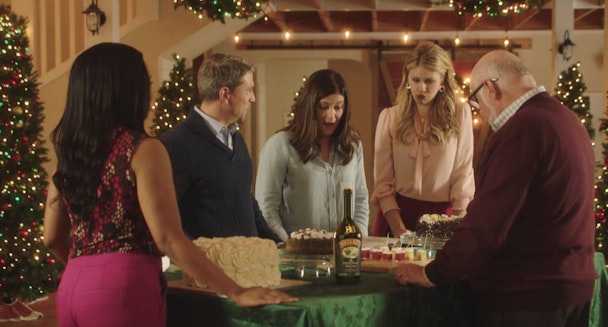How much does it cost to do virtual product placement? Providers share prices and KPIs
There has been a lot of noise around virtual product placement (VPP) as the streamers find non-intrusive ways to bring in advertising revenue, but is it worth it for advertisers?

Baileys’ virtual product placement in Lifetime Movies / Ryff
Digitally inserting products in postproduction is not new technology, but this year it has gained momentum, with Amazon and NBCUniversal building VPP products and adtech firms scaling up its use.
VPP providers such as Ryff, Mirriad and TripleLift say digital brand insertion can cut costs, create extra inventory from archived libraries and give brands more editorial control. But there are still drawbacks preventing full-scale adoption. Accenture Song previously told The Drum that regulation scarpered the development of its VPP software, for example. It’s also early days for VPP measurement.
Advertisement
How much is it going to cost you?
Prices can vary, but VPP can cost as low as $750 for a single placement into influencer content or $5000 to place a product in a popular catalog show, according to Ryff. For a campaign with multiple placements within a premium video, prices can range from $250,000 to $750,000, says Mirriad.
To put that into context, an average 30-spot on national TV costs about $350,000, and traditional product placement in the US can cost upwards of $1m for a single deal. There is also rarely a minimum spend requirement for VPP.
The savings mainly come from logistics, without the need for travel, and personnel times to execute a traditional placement or sponsorship deal.
Mark Melvin, executive vice-president, sales and brand partnerships at Mirriad, says: “VPP budgets are more efficient and deliver media impressions within an advertisers’ campaign flight. Running a campaign of dozens of VPP integrations reaches a broader audience for the advertiser’s investment v the typical seven-figure cost associated with a single traditional product placement buy.”
Advertisement
Is it effective?
A study by Kantar based on Mirriad-run campaigns found that 79% of consumers like contextual VPPs, compared to 12% who said they enjoyed traditional advertising spots. The study exposed audiences to both in-show virtual placements and commercials. It uncovered that brand awareness was 18 percentage points higher with the in-show placement, ad awareness was 25 points higher, favourability was 6 points higher and product consideration was up 9 points.
Measurement is currently platform-dependent, with frequency currently the main metric. Ryff told The Drum it reports on return on advertising spend, return on marketing investment and an assessment of gross rating points. According to its chief executive officer Roy Taylor, on average VPP delivers 300% improvements in efficacy over all other forms of visual advertising.
“It’s not putting a product into one TV show any more – it’s putting it into 500 TV shows, into 500 different episodes,” Taylor says. Ryff tied with Diego-owned brand Baileys in 2020 to run a pilot with Lifetime Movies to digitally insert Baileys into four 15- to 30-second segments across three Christmas films. The result was 10.14m views with a total of 67 seconds of screen time.
Ryff’s goal is to be able to do 1m placements per second. “That is where we are going with this.”
TripleLift has been testing campaigns that combine VPP with a traditional 30-second ad spot. Its general manager of CTV Michael Shields reports that 10 in-show placements running alongside a 30-second spot increased brand awareness by 67% – higher than just running two 30-second spots, which achieved 51% brand awareness.
Suggested newsletters for you
How do deals differ from traditional placement deals?
Product placement broker ScenarioUK tells The Drum deals are based on the production’s audience profile, viewing figures, market reach and length of placement. Then there are guarantee exposure agreements that can be made, as well as editorial influence agreements.
“With the above in mind, PP is very much not an ‘off the shelf’ purchase,” ScenarioUK’s managing partner Matthew Leggett says. Figures can range from Heineken’s $30m for its James Bond placement to Samsung’s deal with Emily in Paris for $2m.
What are the pitfalls?
Production placement isn’t appropriate for all shows. When Ryff worked with Euphoria director Sam Levinson, the sensitivity of the subject matter led him to prohibit VPP within the show. The only brand integration allowed was placing Spotify branding on the computer playing the actual music in the show.
Taylor also warns that inauthentic or “cheesy product placement” can do serious damage. One final piece of advice he gives was not to put products in the hands of the talent. “Unless that talent really truly believes in that product, the audience won’t like it.”

